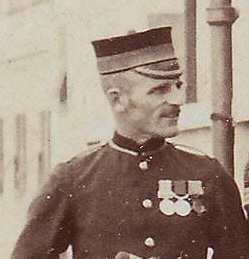
Captain (Quartermaster)
WILLIAM GEORGE DEAN
Royal Engineers
(formerly 15999 Regimental Sergeant Major, R.E.)
by
Lieutenant
Colonel Edward De Santis
Ó 2019.
All Rights Reserved.

Figure 1.
Regimental Sergeant Major William George Dean, R.E., circa 1907.
(Photograph courtesy of The Sapper magazine)
Unless otherwise noted, the most of the details supplied in this narrative were extracted various editions of the Royal Engineers Lists and from sources found on Ancestry.com. These sources are listed in the REFERENCE section at the end of this narrative. Unfortunately his service papers could not be found in the Public Records Office.[i]
William George Dean was a member of a family of Deans who served in the Royal Engineers over a period of at least three generations. Some details regarding the service of other members of the Dean family are presented in this narrative. Full details regarding their lives and service may be found in separate narratives prepared by the author who is in possession of the medals of his grandfather, his father and his brother. The Dean family tree is presented as Appendix A at the end of this narrative.
The
Dean Family
William George Dean was the grandson of 312 Sergeant William Dean, R.E., the son of 4258 Corporal George Dean, R.E., the nephew of 2518 Sapper Josiah John Dean and the brother of Captain Henry James Dean, R.E. All of these men enlisted in the Royal Engineers as a Boy Soldiers and served for full careers in the Army.
William Dean was born in April of 1809 in St. Mary’s Parish, Woolwich, Kent. He was a tailor by trade and he enlisted in the Royal Sappers & Miners[ii] on the 16th of May 1823 as a Boy Soldier. He served for a total of 43 years and 291 days including his time as a Boy Soldier, mostly at the Corps headquarters in Chatham, Kent. His service abroad included 7 years and 1 month in Halifax, Nova Scotia. For his service William Dean was awarded the Long Service and Good Conduct Medal (VR). The whereabouts of this medal is unknown. William Dean was discharged from the Army on the 16th of January 1866.
George Dean was born on the 3rd of September 1840 in Halifax, Nova Scotia, Canada. He enlisted as a Boy Soldier in the Royal Sappers and Miners on the 9th of April 1856. He served as a Bugler and a Driver in the 23rd Company, Royal Engineers, in “A” Troop, Royal Engineers and in “B” Troop, Royal Engineers. His home stations included Aldershot, Shorncliffe and Chatham and his service abroad included India and China. George Dean served for a total of 21 years and 3 days with service abroad totaling 4 years and 31 days. For his service he was awarded the Indian Mutiny 187-1858 Medal with clasps [RELIEF OF LUCKNOW] and [LUCKNOW], the Second China War Medal 1857-60 with clasps [TAKU FORTS] 1860 and [PEKIN 1860] and the Long Service and Good Conduct Medal (VR). George Dean was discharged from the Army on the 9th of September 1879.
Josiah John Dean was born on the 28th of December 1835 in Gillingham, Kent. He enlisted as a Boy Soldier in the Royal Sappers and Miners on the 15th of April 1850. He served as a Sapper in the 1st, 8th, 11th and 29th Companies of the Royal Engineers. His home stations included the Isle of Alderney, Virginia Waters in Surrey, Woolwich, Chatham and Portsmouth. His stations abroad included Turkey, the Crimea, India, Canada, Bermuda and Malta. Josiah Dean served for a total of 21 years and 352 days with service abroad totaling 9 years and 62 days. For his service in the war with Russia he was awarded the Crimean Medal 1854-1856 with clasps [ALMA] [INKERMAN] and [SEBASTOPOL], the Indian Mutiny Medal 1857-1859 with clasp [CENTRAL INDIA] and the Turkish Crimea Medal. As a result of multiple disciplinary actions during his service he was not awarded the Long Service and Good Conduct Medal. Josiah John Dean was discharged from the Army on the 14th of December 1875.
Henry James Dean was born on the 30th of April 1878 at the Female Hospital in Aldershot, Hampshire. He enlisted as a Boy Soldier in the Royal Engineers on the 15th of June 1893. He served in the 11th, 18th, 26th and 37th Field Companies, the Royal Engineers Depot Battalion and in the 4th Labour Battalion. His home stations included Chatham, Aldershot, Falmouth and the Curragh in Ireland. His stations abroad included South Africa and Nova Scotia, Canada. Henry served for a total of 23 years and 191 days with service abroad totaling 5 years and 229 days. For his service in the Second Boer War he was awarded the Queen’s South Africa Medal 1899-1902 with clasps [TUGELA HEIGHTS] [ORANGE FREE STATE] [RELIEF OF LADYSMITH] [TRANSVAAL] and [LAING’S NEK], the King’s South Africa Medal with clasps [SOUTH AFRICA 1901] and [SOUTH AFRICA 1902], the British War Medal and Victory Medal and the Long Service and Good Conduct Medal (GVR). Henry James Dean was commissioned a Lieutenant (Quartermaster) in the Royal Engineers on the 18th of April 1915. He left the Army due to ill health on the 24th of December 1916 and died on the 27th of August 1918.
The
Early Life of William George Dean
William George Dean was born at South Camp in Aldershot, Hampshire on the 18th of February 1865, the son of Corporal George Dean[iii] and his wife Harriet Hannah Dean (née Dadswell). William’s birth was registered on the 21st of February 1865 in the Registration District of Farnham, Sub-district of Frimley, in the County of Surrey and Southampton.[iv] At the time George Dean was serving with the Royal Engineer Train in the military base at Aldershot.
William was the Dean’s first child. They subsequently had six additional children: George Henry William (1866-1942), Frederick (1868-?), Sophia Matilda (1870-1924), Richard Charles (1874-1940), Henry James (1878-1918), David Thomas (1880-1949), Pritchard George (1884-1934) and Frederick G. (1888-1941).
William George Dean enlisted as a Boy Soldier in the Royal Engineers in 1879 and therefore he does not appear in the 1881 or 1891 Census of England and Wales as residing in his father’s home. The 1881 Census of Wales shows the Dean family living Pembrokeshire as shown in the Table 1 below.
Table
1. The 1881 Census of Wales (Milford
Haven, Pembrokeshire)
|
Dwelling:
588 Scoveston Fort |
|||||
|
Census
Place:
Milford Haven, Pembrokeshire |
|||||
|
Source:
National Archives 1881 Census of Wales (RG11/5414) |
|||||
|
Name and Occupation |
Relation |
Marriage Status |
Age |
Sex |
Birthplace |
|
George
Dean |
Head |
Married |
39 |
Male |
Halifax,Nova
Scotia |
|
Harriet
H. Dean |
Wife |
Married |
32 |
Female |
Bermuda |
|
Sophia
[M.] Dean |
Daughter |
|
10 |
Female |
Chatham, |
|
Richard
[C.] Dean |
Son |
|
7 |
Male |
Aldershot, |
|
Henry
J. Dean |
Son |
|
3 |
Male |
Aldershot, |
|
David
T. Dean |
Son |
|
|
Male |
Cirencester, |
NOTES:
By 1891 the Dean family had moved to Dover, Kent as shown by the Census of England and Wales for that year in Table 2.
Table
2. The 1891 Census of England and
Wales (Dover, Kent)
|
Dwelling: 205
Clarindon Gardens |
|||||
|
Census
Place:
Dover, Kent |
|||||
|
Source:
National Archives 1891 Census of England and Wales
(RG12/746) |
|||||
|
Name and Occupation |
Relation |
Marriage Status |
Age |
Sex |
Birthplace |
|
George
Dean |
Head |
Married |
49 |
Male |
Halifax, |
|
Harriet
H. Dean |
Wife |
Married |
42 |
Female |
Bermuda, |
|
Henry
J. Dean |
Son |
|
13 |
Male |
Aldershot, |
|
David
T. Dean |
Son |
|
11 |
Male |
Cirencester, |
|
Pritchard
G. Dean |
Son |
|
9 |
Male |
Scoveston, |
|
Frederick
G. Dean |
Son |
|
3 |
Male |
Scoveston, |
NOTES:
William George Dean and his family appear in the 1891 and 1911 Census
of England and Wales, as will be seen in a later section of this narrative.
However, they do not appear in the 1901 Census.
3. ENLISTMENT AND
TRAINING
William George Dean enlisted as a Boy Soldier in the Royal Engineers on the 26th of May 1879 at the age of 14 years.[v] Upon his enlistment he was subjected to a preliminary medical examination and a preliminary military examination and was found fit for service. He was assigned Regimental Number 15999 and probably was posted to the Royal Engineers Depot at Chatham, Kent where he may have served as a Bugler. On the 26th of February 1883, upon reaching his 18th birthday, he joined the ranks as a Sapper.
4.
ASSIGNMENTS AND CAMPAIGN SERVICE
Home
Service (1883-1884)
Upon entering the ranks as a Sapper, Dean underwent training in the skills of an engineer soldier.[vi] Upon completion of his training he was posted to the 8th Company, Royal Engineers.[vii] At this time (June of 1884) the company was located at Chatham and was training with the London, Chatham and Dover Railway in preparation to its conversion to a Railway Company.
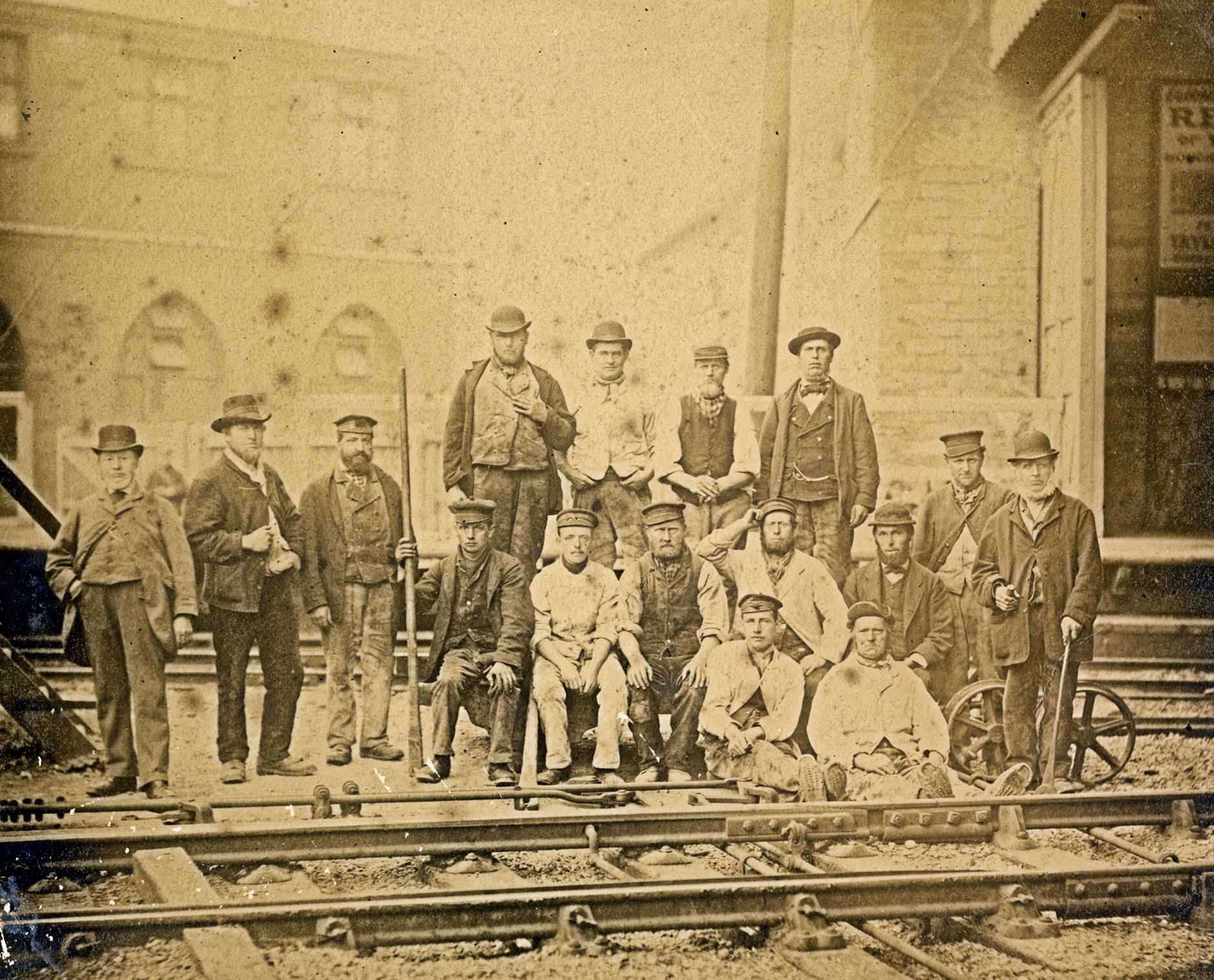
Figure 2. Men of the London,
Chatham and Dover Railway Who May Have Trained the Sappers of the 8th
Company, Royal Engineers in 1884.
(Photograph courtesy of The Dover Historian)
Egypt
(1885-1886)
On the 5th of October 1884 the 8th (Railway) Company reached Wadi Halfa in Egypt where it began its service in the Soudan Campaign of 1884-1885. The following men were officers in the company at that time:[viii]
Major Douglas Alexander Scott,[ix] R.E. (Officer Commanding)
Captain George Frederick Wilson, R.E.[x]
Captain Pelham George Von Donop, R.E.[xi]
Captain James Archibald Ferrier, R.E.[xii]
Lieutenant William Sealy Vidal, R.E.
Lieutenant Alexander William Roper, R.E.[xiii]
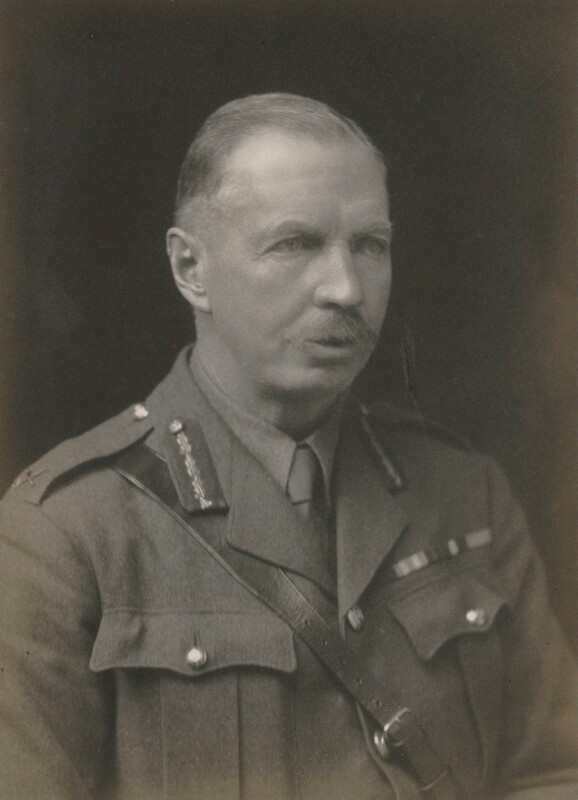
Figure 3. Major General
Alexander William Roper, C.B.E., circa 1914.
(Photograph courtesy of Wikipedia.com)
The 8th (Railway) Company became part of the Nile Expedition, sometimes called the Gordon Relief Expedition (1884–85). This was a British mission to relieve Major-General Charles George Gordon at Khartoum, Sudan. Gordon had been sent to the Sudan to help Egyptians evacuate from Sudan after Britain decided to abandon the country in the face of a rebellion led by self-proclaimed Mahdi, Mahommed Ahmed. The company was to play an important role in this expedition in an attempt to construct and maintain a railway to assist in the movement of British troops to Khartoum.
The company’s arrival at Wadi Halfa was the start of an eighteen-month deployment that saw them involved in the advance towards Khartoum, the retreat from Sudan after the fall of Khartoum and then consolidation work along the southern Egyptian border. On arrival they were set to work immediately repairing the existing railway south along the Nile to Saras, and then extending it further across the desert to Ambigol Wells and beyond. The official history of the campaign reveals the prodigious work involved: ‘the repair and maintenance of 33 and a half miles of existing railway, the construction of nearly 54 miles of line through barren country, the transport of 9,000 troops around the worst part of the Second Cataract in ascending the Nile and round almost the whole of it in descending that river, and the carriage of 40,000 tons of stores and munitions.[xiv]
The work was not without danger: Captain J.A. Ferrier, R.E., a veteran of the 1878-81 Afghan War, had the distinction of commanding the fort at Ambigol Wells in early December 1885 during one of the final actions of the campaign, when a force of some 700 dervishes cut the railway line to the north and south and surrounded the oasis, reputedly shouting to Ferrier and his little garrison, ‘railway finish, telegraph finish, you finish.’ In a version of Rorke’s Drift in the 1879 Zulu War Ferrier and his men defended their post against fierce attacks until a relief column arrived, the first of several actions over the final weeks of the campaign for which he was awarded the Distinguished Service Order.[xv]
Whether or not Dean was present at Ambigol Wells is unknown, as his Army record could not be located during the research of his life and military service. However, it seems likely that if he was with his company he would have seen persistent skirmishing with the Mahdist forces over those final months as they toiled deep into the desert to the final station at Akasha, 87 miles from Wadi Halfa and well within Mahdist territory.
The map below shows the route of the railway worked on by the 8th (Railway) Company starting at Wadi Halfa and heading south across the Nubian Desert to Abu Hamed and then to Berber and Atbara Camp on the Atbara River. Dean served in the rank of 2nd Corporal during these operations in the Sudan as part of the Frontier Field Force throughout 1885 and into 1886. For his service in this campaign he was awarded the Egypt Medal 1882 with clasp [THE NILE 1884-5]. He also was awarded the Khedive’s Star by the government of Egypt.
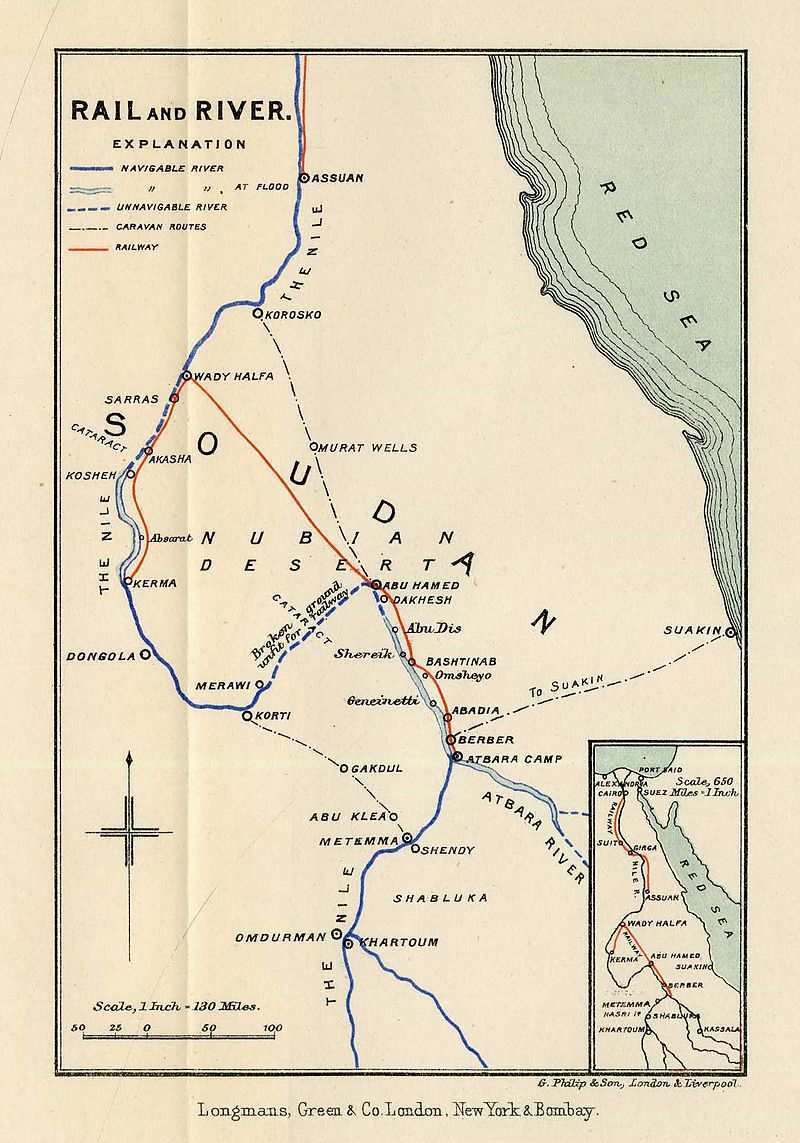
Figure 4. Map of the Rivers
and Railway in the Soudan in 1884.
(Map courtesy of Wikipedia.com)
Home Service (1886-1905)[xvi]
After
returning home from Egypt Dean was posted to the Royal Engineers Depot at
Chatham where he spent a considerable amount of time.
While at Chatham he married and he and his wife Margaret had three
daughters (Amy Margaret, born in 1890, Ella Beryl, born in 1893 and Myra
Lillian, born in 1902).
The
1891 Census of England and Wales shows him and his wife and youngest daughter
living at New Brompton, Kent along with the information presented in Table 4
below. Ella and Myra were no longer
living with their parents.
Table 3. The 1891
Census of England and Wales.
|
Dwelling:
9 Stanley Road. |
||||
|
Census
Place:
New Brompton, Chatham, Kent. |
||||
|
Source:
National Archives 1891 Census of England and Wales
(RG10/660). |
||||
|
Name and Occupation |
Relation |
Marriage Status |
Age |
Birthplace |
|
William
G. Dean |
Head |
Married |
26 |
Aldershot,
|
|
Margaret
E. Dean |
Wife |
Married |
26 |
Dover,
|
|
Amy
M. Dean |
Daughter |
|
1 |
Chatham,
|
Dean
completed 18 years of service and was awarded the Long Service and Good Conduct
Medal when he was a Quartermaster Sergeant (Warrant Officer Class 2).
He subsequently rose to the rank of Regimental Sergeant Major (Warrant
Officer Class 1) in the Royal Engineers Service Battalion.
He had served in the ranks for 23 years and 69 days when he was promoted
to Warrant Officer Class 2 at the age of 37.
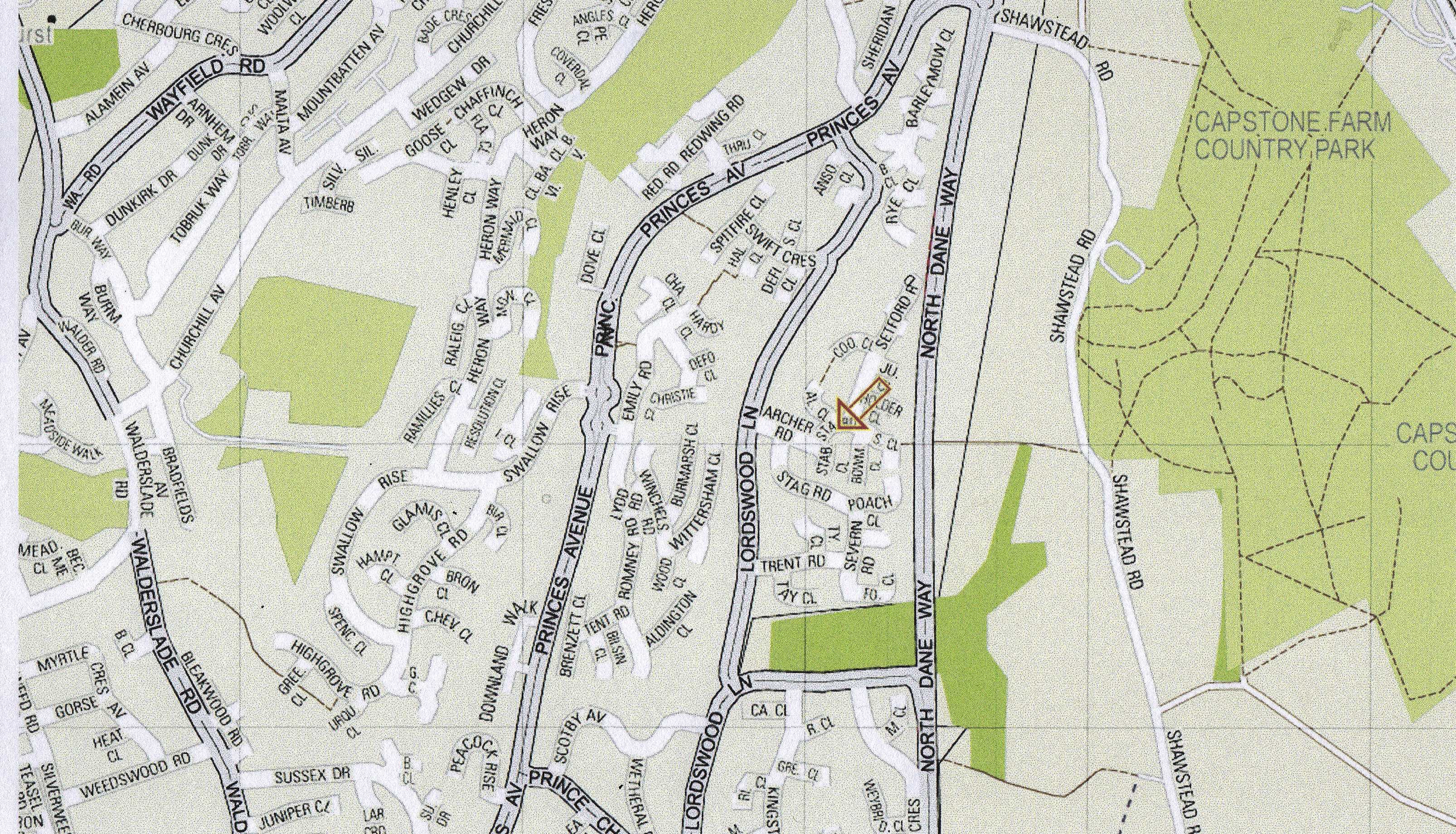
Figure 5.
Stanley Road, Chatham, Kent.
(Map courtesy of Street Maps UK)
NOTE: The
present homes (2019) on Stanley Road are new and have been constructed since the
Deans lived on this street, therefore the house at 9 Stanley Road where they
lived in no longer there.
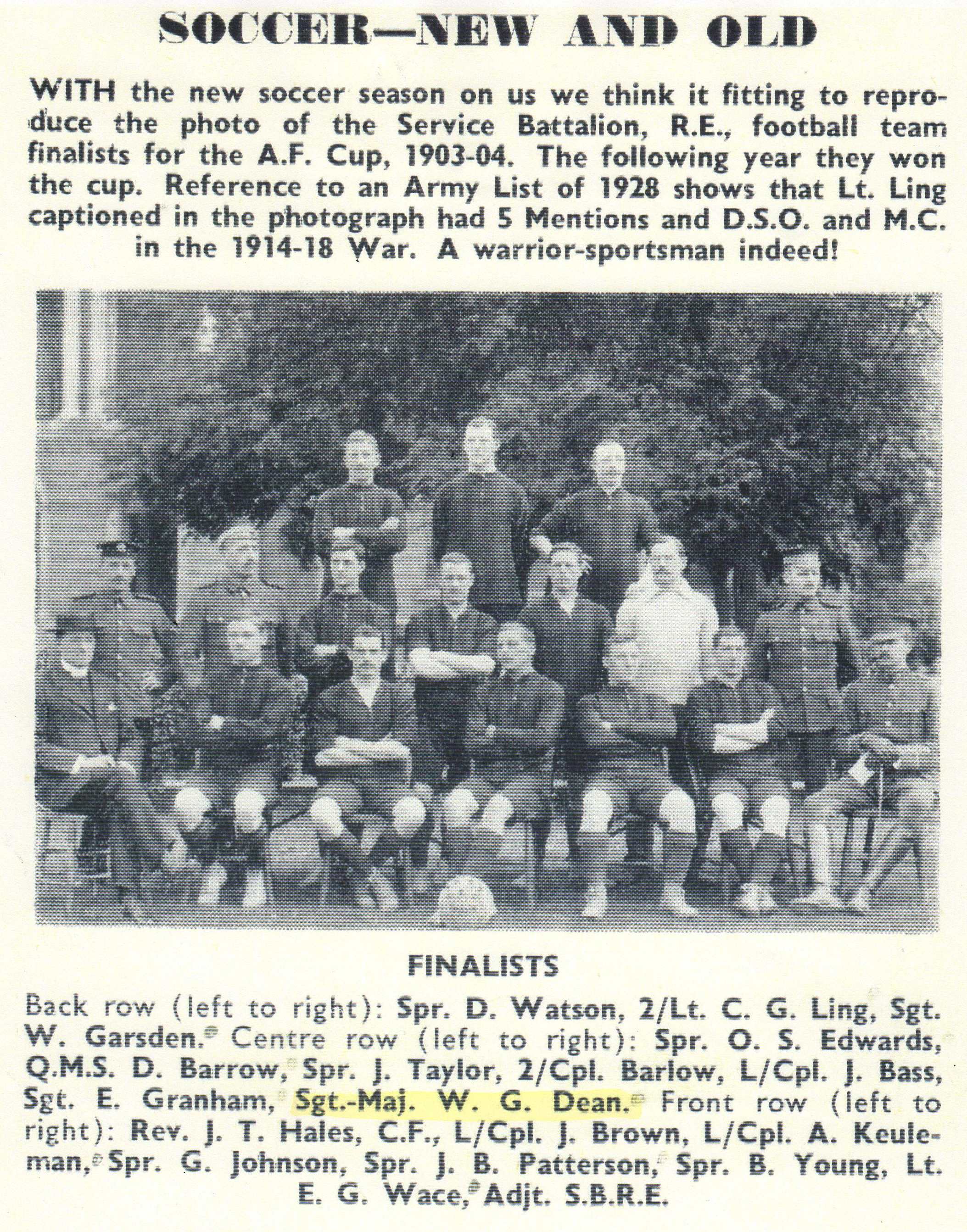
Figure 6.
The Royal Engineers Service Battalion Soccer Team.
(Photograph courtesy of The Sapper magazine, October 1960).
NOTE:
Sergeant Major W.G. Dean is standing in the middle row, far right.
Gibraltar (1905-1908)
Regimental
Sergeant Major Dean was posted to Gibraltar, probably about 1905, and served
there until July of 1908 when he received orders to return to England.
Again, his specific assignment in Gibraltar is not known because his
service papers are not available. He
had been commissioned an Honorary Lieutenant (Quartermaster) on the 3rd
of June 1908 while serving at Gibraltar.[xvii]
By the date of his commissioning he had served 5 years and 305 days as a
Warrant Officer.
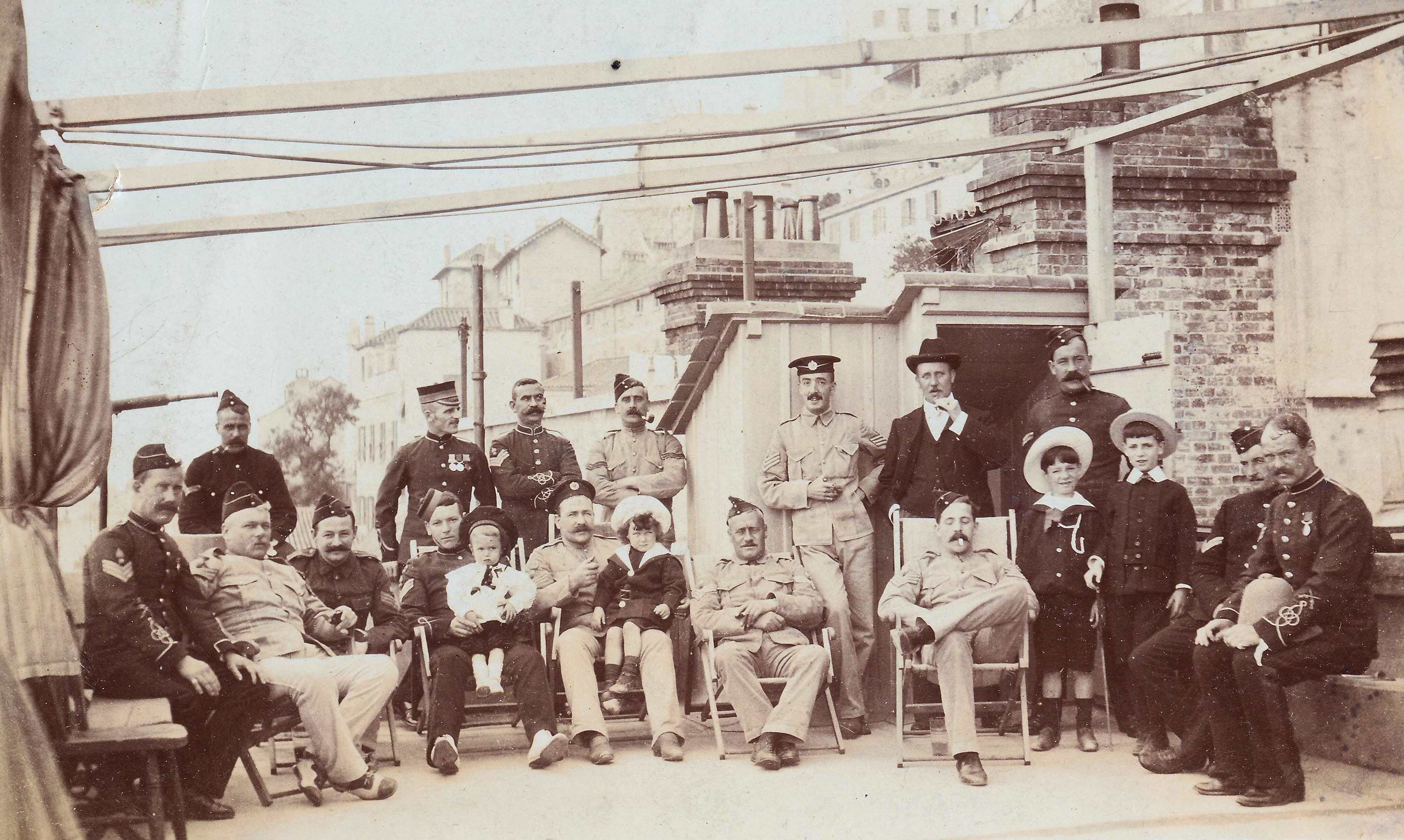
Figure 7.
Roof of the Sergeants’ Mess, Gibraltar, c. 1907.
(Photograph courtesy of The Sapper magazine)
NOTE: In
the photograph above Regimental Sergeant Major William George Dean is standing,
second from the left. The Sergeant
in the tropical dress uniform, seated in the deck chair on the right and smoking
a cigarette, is Frederick Charles Barnes, the future husband of Dean’s sister
Amy.
Home Service (1908-1912)
By
August of 1908 Lieutenant Dean was serving in the Eastern Command at Colchester
in Essex where he was the Officer in Charge of Stores at the Royal Engineers
Headquarters Office, Colchester.[xviii]
While in this position he worked under Brevet Colonel H.S. King,
Commander Royal Engineers Colchester. Table
3 shows the members of the Dean family in 1911.
Table 4. The 1911
Census of England and Wales.
|
Dwelling: 27
Athelstan Road. |
||||
|
Census
Place:
Colchester, Essex. |
||||
|
Source:
National Archives 1911 Census of England and Wales. |
||||
|
Name and Occupation |
Relation |
Marriage Status |
Age |
Birthplace |
|
William
George DeanLieutenant, Royal Engineers |
Head |
Married |
46 |
Aldershot,
|
|
Margaret
Dean |
Wife |
Married |
46 |
Dover,
|
|
Ella
Dean |
Daughter |
Single |
18 |
New
Brompton, Kent |
|
Myra
Dean |
Daughter |
|
9 |
New
Brompton, Kent |
|
Hilda
Cox |
Servant |
Single |
19 |
Wivenhoe, |
Amy Margaret Dean, who would have been 21 years old in 1911, was no longer living with her parents. Amy had married Frederick Charles Barnes in 1910 and was living at 18 Irvine Road in Colchester. Frederick Charles Barnes was a Sergeant in the Royal Engineers and he had served with Regimental Sergeant Major Dean in Gibraltar in 1907 (See Figure 8).
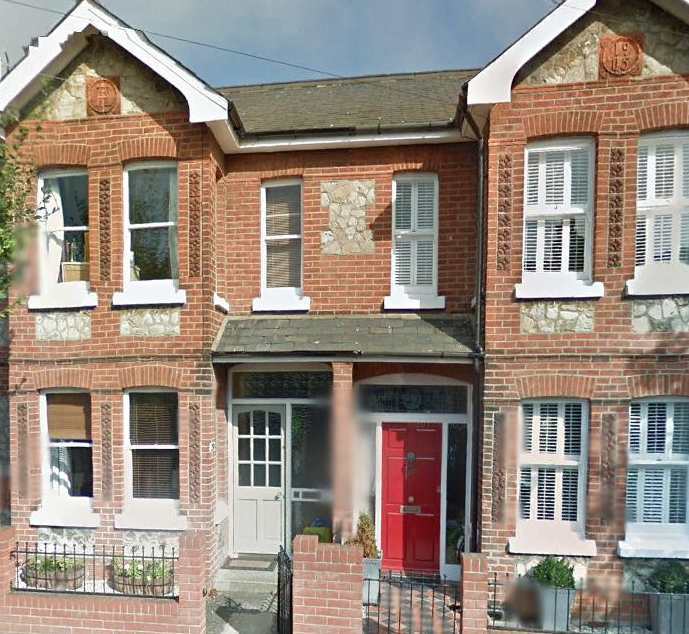
Figure 8. 27 Athelstan Road,
Colchester (building with the red door).[xix]
(Photograph courtesy of Google Earth)
South Africa (1912-1920)
By January of 1912 Lieutenant Dean was serving at Tempe in the Orange Free State, South Africa, as the Officer in Charge of Stores at the Royal Engineers headquarters.[xx] His responsibilities extended throughout the Cape of Good Hope District with his office located in The Castle in Cape Town.[xxi] The Castle of Good Hope is the oldest surviving colonial building in South Africa. It was built in the 1600s. It is shaped in a pentagon with five bastions and flaunts both elements of Medieval and English Renaissance architecture. Before the land reclamation forced the building inland, it was originally a marker of the Table Bay shoreline. This fortress was once the center of civilian, administrative and military life in the Cape. The Castle formed part of a formidable defensive system at the Cape that discouraged attacks. It has never been attacked.
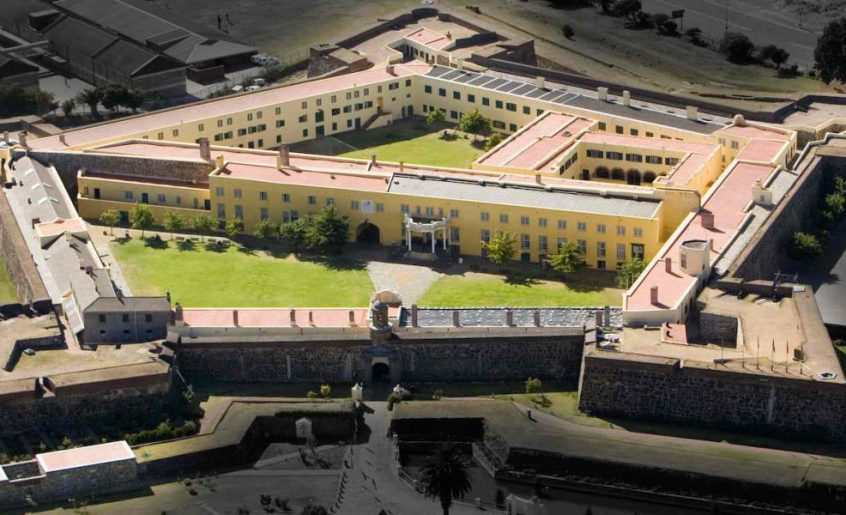
Figure 9. The Castle in Cape
Town, South Africa.
(Photograph courtesy of Early Colonial Style Travel)
When the Great War broke out in August of 1914, Lieutenant Dean was still serving in South Africa. His Medal Index Card shows that he was credited with war service beginning on that date even though he was not in an active theatre of the war.
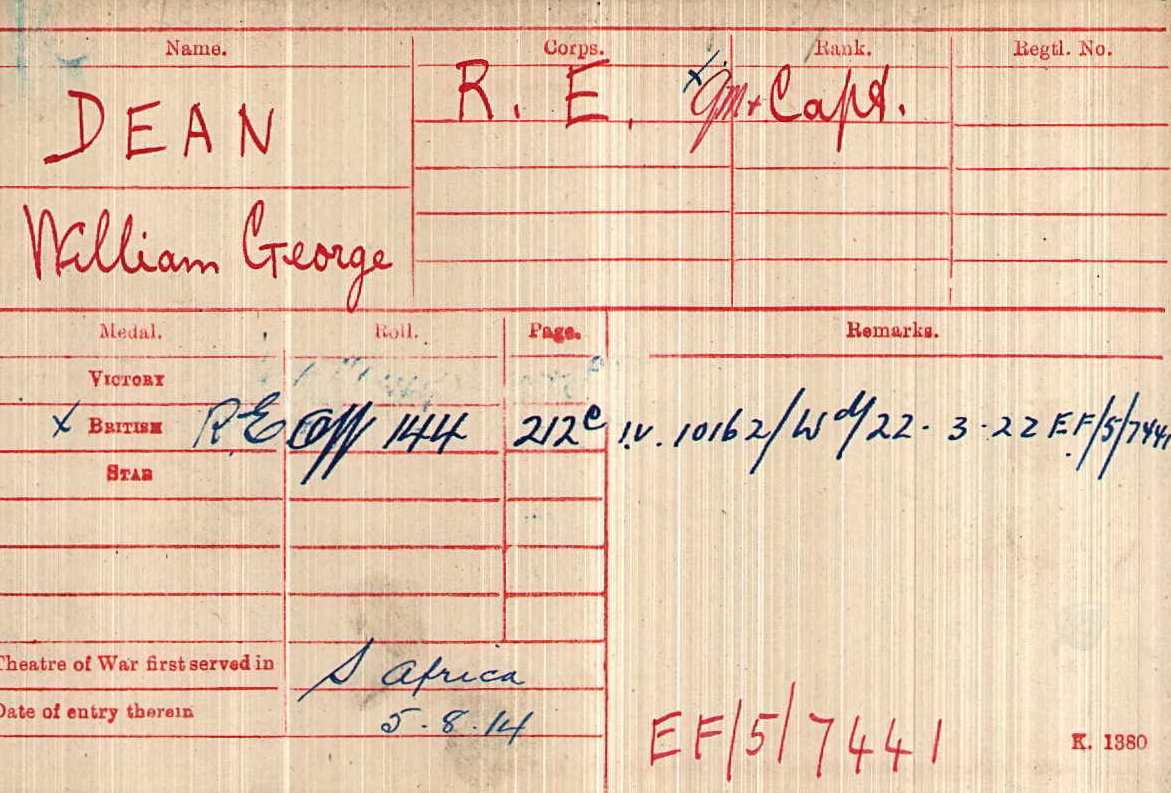
Figure 10. The Great War
Medal Index Card of William George Dean, R.E.
(Image courtesy of Ancestry.com)
On the 1st of July 1917, while still in South Africa, Dean was
promoted to the rank of Captain (Quartermaster).
He served in South Africa throughout the period of the Great War and
planned to retire from the Army on the 1st of May 1920.
He booked passage on S.S. Prince of
Wales to depart from Natal and Cape ports via Madeira with a destination of
Southampton. The ship’s manifest
shows him as a Captain, R.E., age 55. For
some reason he did not sail on this ship as his name is struck through on the
manifest. He did, however, return to
England shortly thereafter and retired from the Army on the 1st of
May.[xxii]
On the 30th of September 1921 he was living at 1 Litchfield
Way in Onslow Village, Guildford, Surrey.[xxiii]
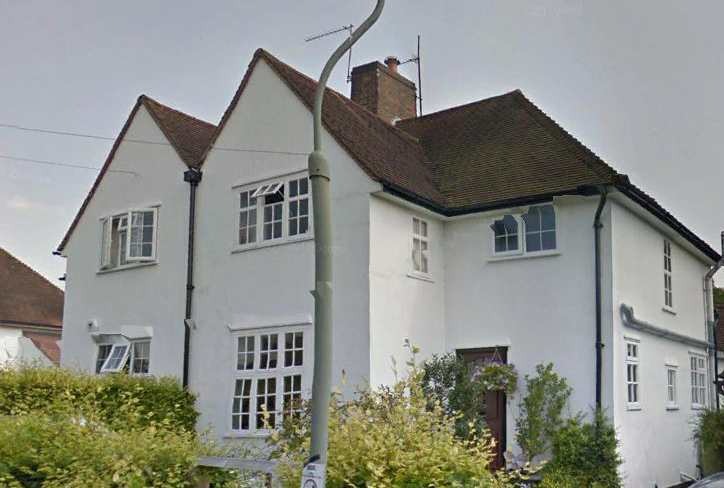
Figure
11. 1 Litchfield Way, Guildford,
Surrey.
(Image courtesy of Google Earth)
6. AWARDS, DECORATIONS AND MEDALS
Captain William George Dean was awarded the following medals during service in the Army.[xxiv]
1. The Egypt 1882 Medal with clasp [THE NILE 1884-85], named to him as follows: 15999.2/CORP:W.G.DEAN ( ) CO R.E. (Note: The company designation (8th Railway Company) has been obliterated by wear.
2. The British War Medal, named to him as follows: Q.M.& CAPT. W.G.DEAN.
3. The Army Long Service and Good Conduct Medal (VR) named to him as follows: 15999 Q:M:SGT.W.G.DEAN.R.E.
4. The Khedive’s Star 1884-6, un-named as issued.
The medals are shown in Figure 6 below in the order listed above from left to right.
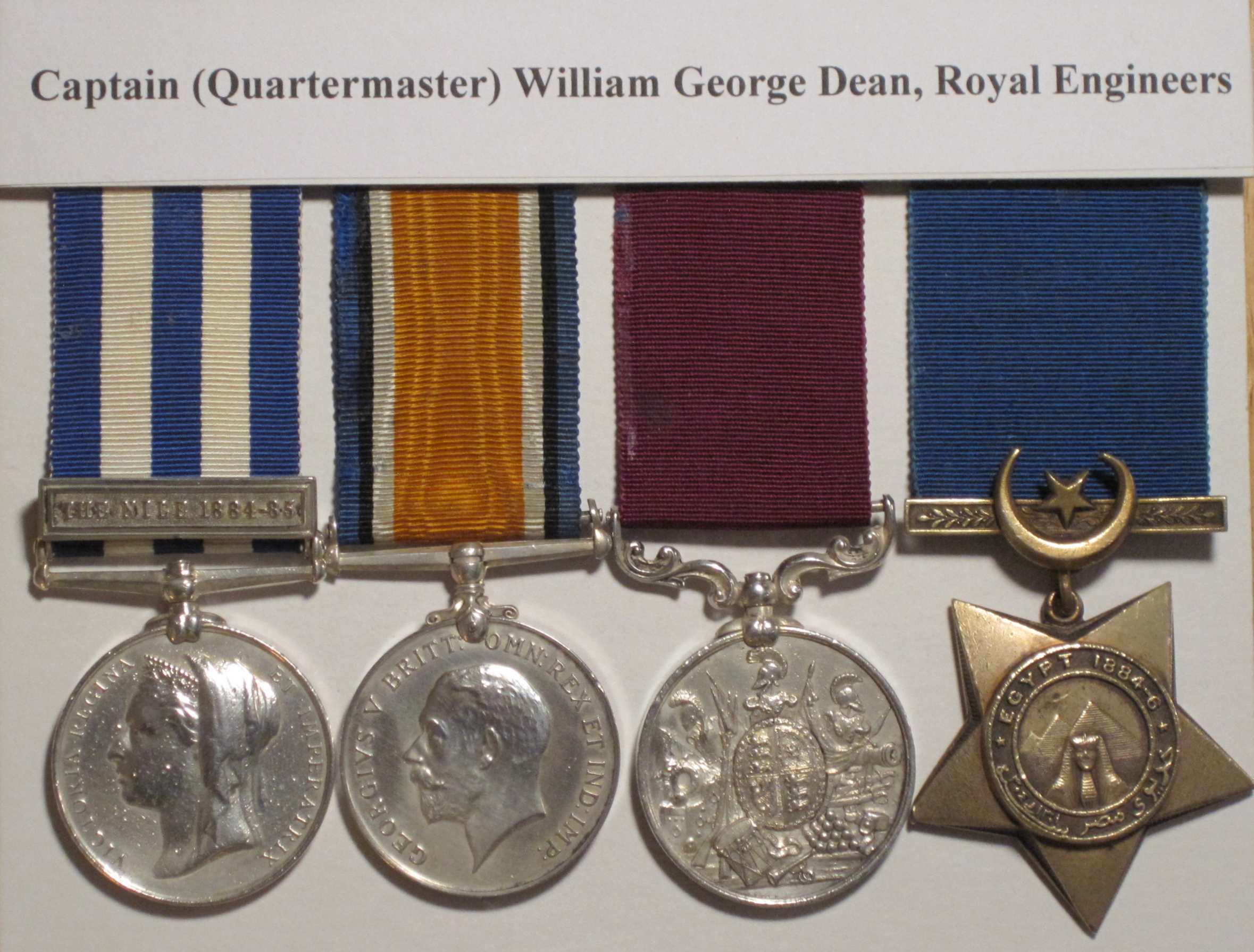
Figure 12. The Medals of Captain William George Dean, R.E.
(Photograph of medals in the author’s collection)
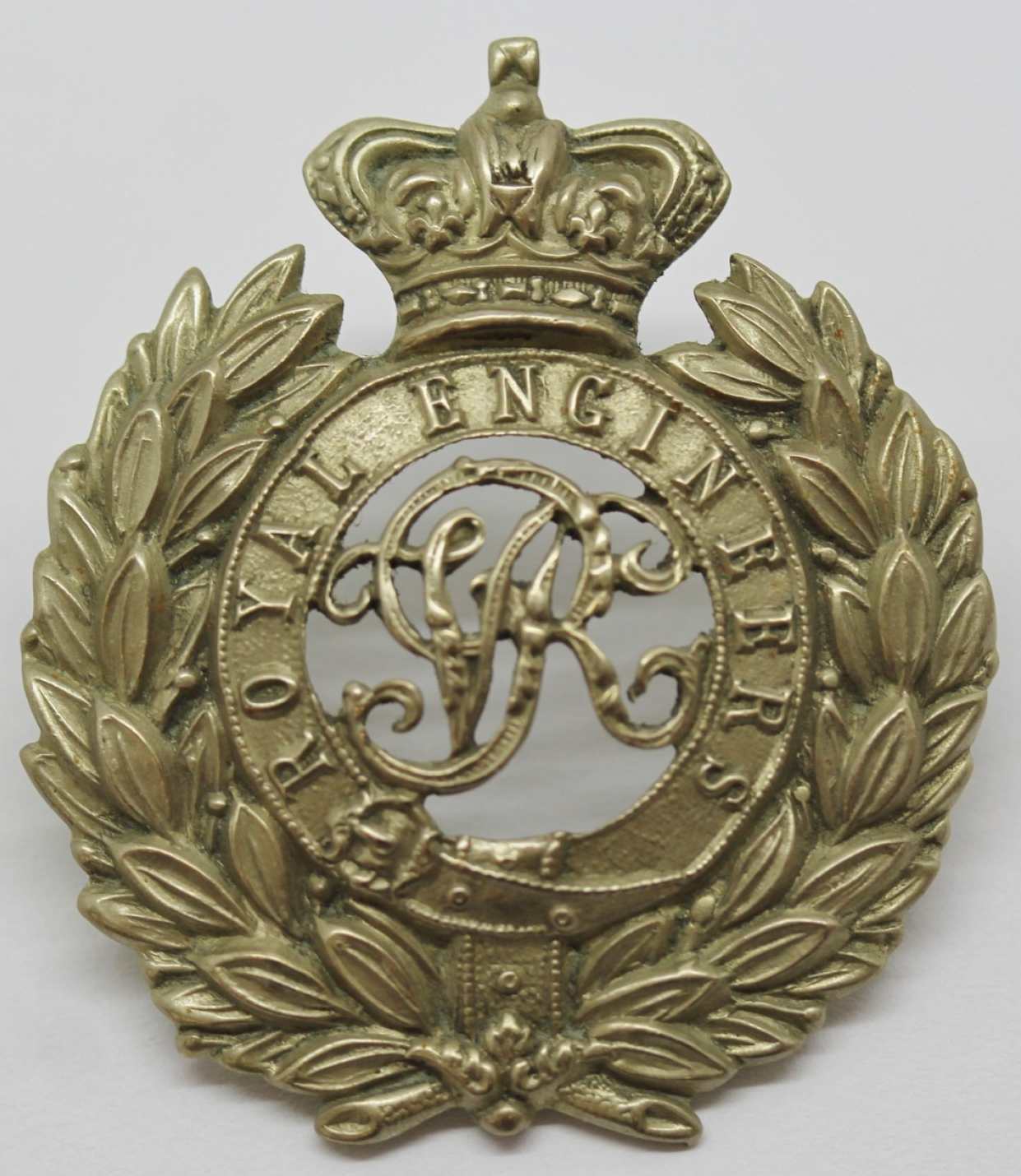
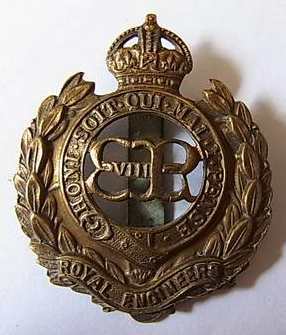
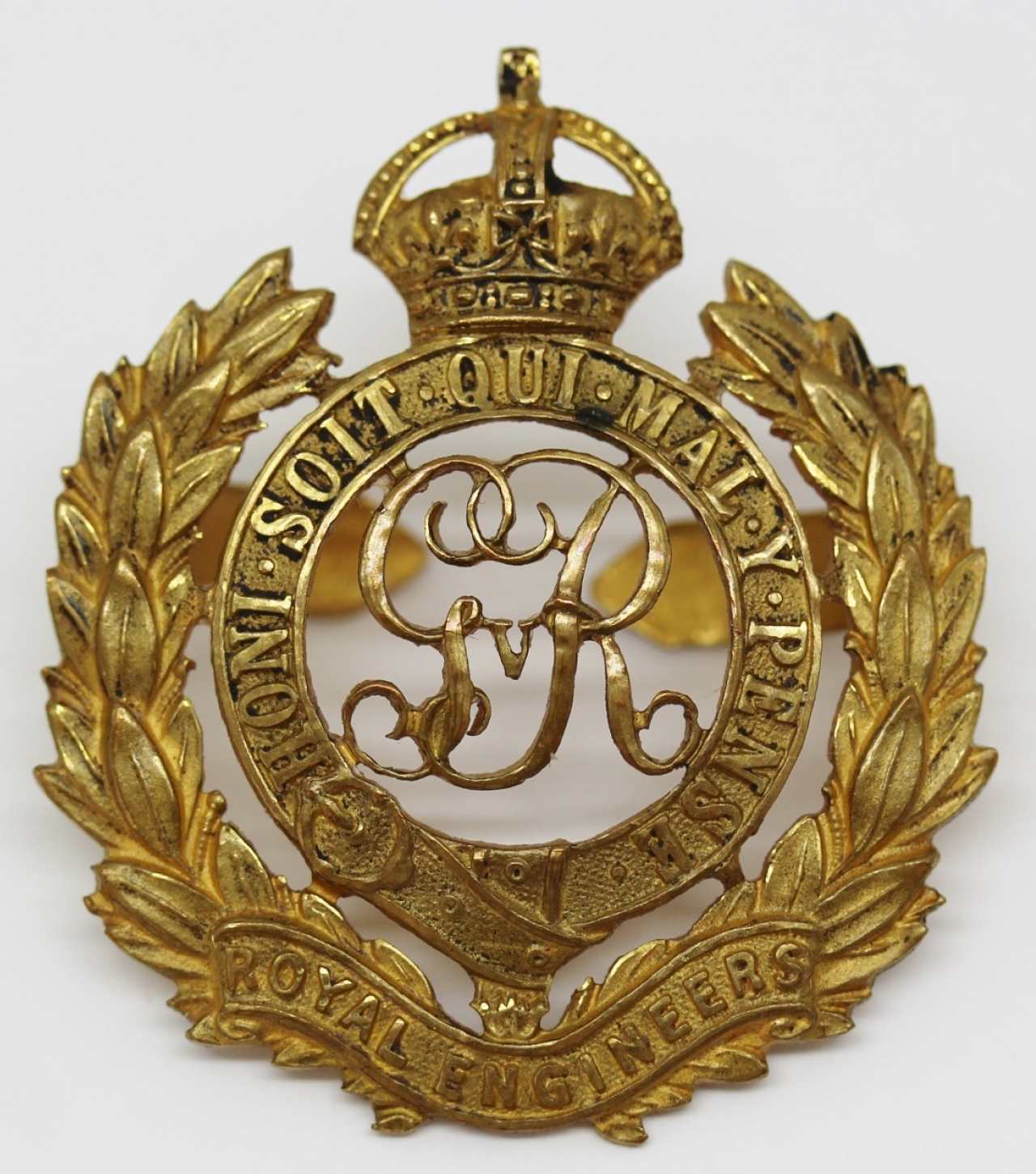
Figure 13. Victorian, Edward VII and George V Royal Engineers Cap Badges as Worn by Regiment Sergeant Major and later Captain William George Dean.
The following sections of this narrative summarize the key events in the life of William George Dean. They are presented in tabular form to allow the reader to see the significance events in his life and when they occurred.
7. PROMOTIONS AND CONDUCT
a. Promotions: William George Dean received promotions shown in Table 4.
Table
4. The Promotions or Appointments of
Captain William George Dean, R.E.
Date of Promotion or Appointment[xxv] |
Rank or Position |
|
26 May 1879 |
Enlisted as a Boy Soldier. |
|
26 February 1883 |
Entered the ranks as a Sapper. |
|
26 September 1885 |
Promoted 2nd Corporal.[xxvi] |
|
About 1888 |
Promoted Corporal. |
|
About 1891 |
Promoted Sergeant. |
|
About 1897 |
Promoted Quartermaster Sergeant (Warrant Officer Class 2). |
|
About 1903 |
Promoted Regimental Sergeant Major (Warrant Officer Class 1. |
|
3 June 1908 |
Commissioned Lieutenant (Quartermaster). |
|
1 July 1917 |
Promoted Captain (Quartermaster). |
b. Qualifications: Again, without his service papers it is not possible to know what military qualifications William George Dean might have earned while serving in the ranks. His training and service in the 8th Railway Company may have earned him some railroad construction-related qualifications. His service as an officer in charge of stores during his time in Colchester and South Africa would indicate that he had some supply and logistics qualifications.
9. MEDICAL INFORMATION
No medical information pertaining to William George Dean was uncovered
during this research, primarily due to the non-availability of his service
papers.
10. MARRIAGE AND PERSONAL
INFORMATION
Marriage
William George Dean married Margaret Elizabeth Snelling in the Church of
St. John the Evangelist in Kent on the 4th of June 1889.
At the time of their marriage William’s residence was listed as
Brompton [Barracks], Chatham and his occupation was given as Soldier.[xxvii]
The bride’s residence was listed as 3 Gordon Terrace in Blackheath,
London. William’s father, George
Dean, is listed on the marriage certificate as a Caretaker.
Margaret’s father, James Henry Snelling, is listed as Bricklayer.
A witness to the wedding is shown as Sergeant A. Snelling, R.E., most
likely the brother of the bride and an Army friend of William’s.

Figure 14. The Dean-Snelling
Wedding Certificate.
(Image courtesy of Ancestry.com)
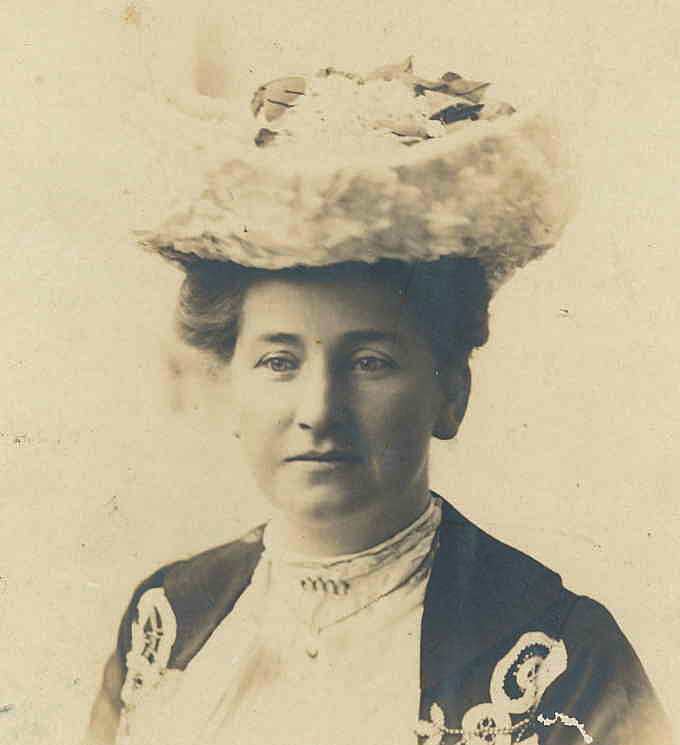
Figure 15.
Margaret Elizabeth Dean (née Snelling).
(Photograph courtesy of The Dean Family Tree, Ancestry.com)
The
Dean Family
As previously indicated, William George Dean came from a large family with his grandfather (312 Sergeant William Dean), his father (4258 Sapper George Dean) and one brother (Captain Henry James Dean) serving in the Corps of Royal Engineers. Of his siblings, only the following information is known (See Appendix A – The Dean Family Tree).
§ A brother, George Henry William Dean, born in Southampton on the 13th of May 1865. He served in the Royal Navy as a Stoker on 17 different ships between the 16th of December 1884 and the 31st of December 1904 when he retired with a pension. He then joined the Royal Fleet Reserve on the 1st of January 1905. George Henry William Dean died in Plymouth, Devonshire in December of 1942.
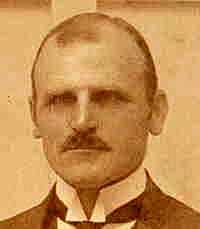
Figure 16. George Henry
William Dean.
§ A brother, Frederick Dean, born in Sandgate, Kent in 1868.
§ A sister, Sophia Matilda Dean, born in 1870. Sophia was married to a man named Frederick Hammond in Dover, Kent in 1890. Sophia died in Woolwich, London on the 11th of June 1924.
§ A brother, Richard Charles Dean, born in Aldershot, Hampshire in 1874. Richard also may have served in the Royal Engineers during the Great War. A Medal Index Card exists for a man by this name, 1310 (514544) Warrant Officer Class 2 Richard C. Dean who served in the Territorial Force and was entitled to both the British War Medal and Victory Medal. Richard Charles Dean attested at Plymouth on the 31st of October 1914 for the period of the Great War and served as Company Sergeant Major of the 570th (Devon) Works Company, R.E. His service papers are in the burnt records files at the National Archives, but unfortunately his papers do not show any names of relatives with the exception of his wife whose name was Caroline Beatrice. With such a large number of the Dean family serving in the Royal Engineers, this man may very well have been the brother of William George Dean. Richard Charles Dean died in 1940.
· A brother, Henry James Dean, born in Aldershot, Hampshire on the 30th of April 1878. Henry James Dean also served in the Royal Engineers, enlisting as a Boy Soldier and then serving in the ranks as a Sergeant Major. He subsequently was commissioned and rose to the rank of Captain and served in the Great War of 1914-1918. Henry died of disease on the 27th of August 1918 Mundesley, Norfolk. His medals also are in the author’s collection.
· A brother, David Thomas Dean, born in Cirencester, Gloucestershire 1880. He died in Woolwich in 1949. Medal Index Cards for the Great War indicate that four men by this name served. They were:
§ 2337 Corporal David T. Dean, Army Ordnance Corps
§ 31726 Corporal David T. Dean, Devonshire Regiment
§ M-347962 Private David T. Dean, Army Service Corps
§ 109637 Warrant Officer Class 2 David Dean, later 2nd Lieutenant, Royal Engineers. Although no middle initial is given for this man, the Royal Engineers connection cannot be ignored.
· A brother, Pritchard George Dean, born in Scoveston, South Wales in 1884. He married Violet Mary Ann Thomas in Hoo, Kent in 1909. Pritchard died in Edinburgh, Scotland on the 20th of February 1934. No indication of military service has been found for him. He would have been 30 years old at the start of the Great War.
· A brother, Frederick G. Dean, born in Scoveston, South Wales in September of 1888. He died in 1941. He would have been 26 years old at the start of the Great War. Medal Index Cards indicate that three men by this name served. They were:
§ 99123 Gunner Frederick G. Dean, R.G.A., later M/38499 Army Service Corps
§ 1581 Private Frederick G. Dean, Hertfordshire Regiment, later 27009 Somerset Light Infantry.
§
36577 Gunner Frederick G. Dean, Royal Garrison Artillery.
No positive connection has been made between any of these men and the Royal Engineers of the Dean family.
·
His grandfather, 312 Sergeant William Dean, R.E., died in 1883 and
his grandmother, Mary Ann Dean (née Edwards) died in 1864.
·
His father 4258 Sapper George Dean served in the Royal Engineers.
George Dean served in the Indian Mutiny and in the 1860 China War.
His date of death is not known. His
medals also are in the author’s collection.
· His mother, Harriett Hannah Dean (née Dadswell) was born in 1849 and died in Medway, Kent in December of 1917.
William George Dean’s Children
The Dean’s first child, Amy Margaret (Annie), was born in Gillingham, Kent in 1890. She married Frederick Charles Barnes in Gillingham, Kent in the 4th Quarter of 1890. Amy died in 1973.
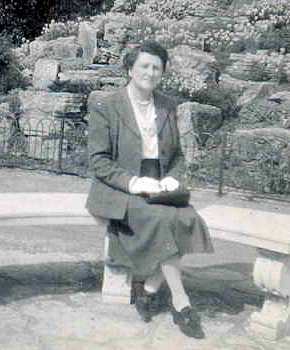
Figure 17. Amy Margaret
Barnes (née Dean).
(Photograph courtesy of the Barnes Family Tree, Ancestry.com)
The Dean’s second child, Ella Beryl, was born in New Brompton, Kent in 1893. She married a man by the name of George Marshall. The date of Ella’s death is not known.
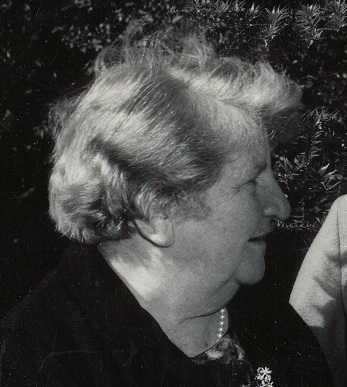
Figure 18. Ella Beryl
Marshall (née Dean).
(Photograph courtesy of the Barnes Family Tree, Ancestry.com)
The Dean’s third child, Myra Lillian, was born in New Brompton, Kent in January of 1902. She married a man named Jack Harris. The date of Myra’s death is not known.
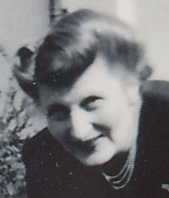
Figure 19. Myra Lillian
Harris (née Dean).
(Photograph courtesy of the Barnes Family Tree, Ancestry.com)
11. DISCHARGE
William George Dean’s total service was reckoned as shown in the tables below. Since his service papers could not be found, the specific dates of his movements in many cases are not known.
Table
5. Geographic Areas and Periods of
Service where William George Dean Served.
Location |
Approximate
Period of Service |
|
Chatham, Kent (As a Boy Soldier) |
26 May 1879 – 25 February 1883 |
|
Chatham, Kent |
26 February 1883 - 1884 |
|
Soudan |
1884 - 1886 |
|
Chatham, Kent |
1886 - 1905 |
|
Gibraltar |
1905 – July 1908 |
|
Colchester, Essex |
August 1908 – December 1911 |
|
South Africa |
January 1912 – May 1920 |
Location |
Approximate
Period of Service |
|
Home |
27 years and 6 months |
|
Abroad |
14 years |
Total Service |
41 years and 6 months |
After leaving the Army Captain Dean and his family took up residence at 1 Litchfield Way in Onslow Village, Guildford, Surrey. In addition to his wife, only his daughter Myra was living with him at the time.
On the 4th of October 1923 Dean and his family sailed aboard SS Balranald from London, bound for Cape Town, South Africa. The ship’s manifest listed South Africa as their intended place of residence. It may be that Captain Dean’s found Cape Town to be a place to visit again after his duty there during the Great War, or perhaps he found the climate and geography to his liking and may have thought to settle there. At any rate he and his family did not remain there permanently. They returned to England sometime between 1923 and 1929.
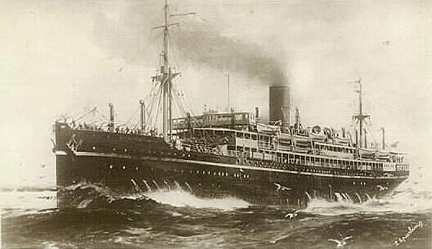
Figure 20. S.S. Balranald.
(Photograph courtesy of Wikipedia.com)
On the 12th of December 1929 Captain and Mrs. Dean departed England aboard SS Guildford Castle bound once again for Cape Town. Their home address is listed on the ship’s manifest as Blackfriar Road in Sidcup, a district of southeast London.
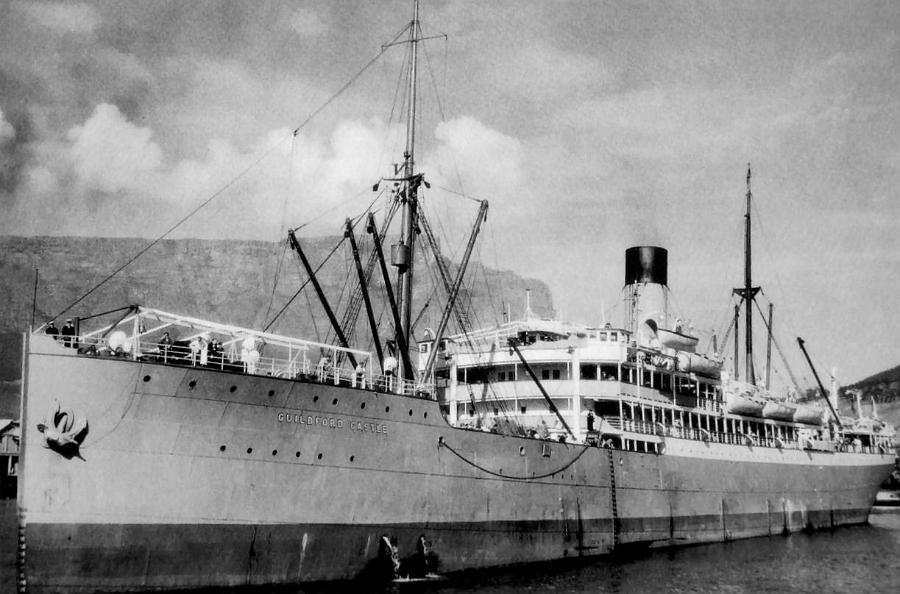
Figure 21. S.S. Guildford Castle.
(Photograph courtesy of Band Staff Register)
In April of 1930 the Deans were living at Hadleigh on Blackfen Road in Sidcup[xxviii] and in July of 1930 they were living in Mowbray Hall, Main Road, Rosebank in Cape Town South Africa.[xxix] In April of 1931 Captain Dean’s postal address was in care of the Officer in Charge, Imperial Pensions, Pretoria, South Africa.[xxx] From these addresses it would appear that Captain and Mrs. Dean at least had temporary residences in South Africa between 1923 and 1931.
In October of 1932 the Deans were residing at Wynberg on Parklands Drive in Broughton, Preston, Lancashire.[xxxi] In April of 1934, Captain Dean, now a widower, was living at 104 Holmsdale Grove in Barnhurst, Kent.[xxxii]
Captain William George Dean was still living in 1943, age 73 years, and
was residing at 10 West Street in Tavistock, Devonshire.
No record of his death was found during the course of this research.
APPENDIX
A. THE DEAN FAMILY TREE
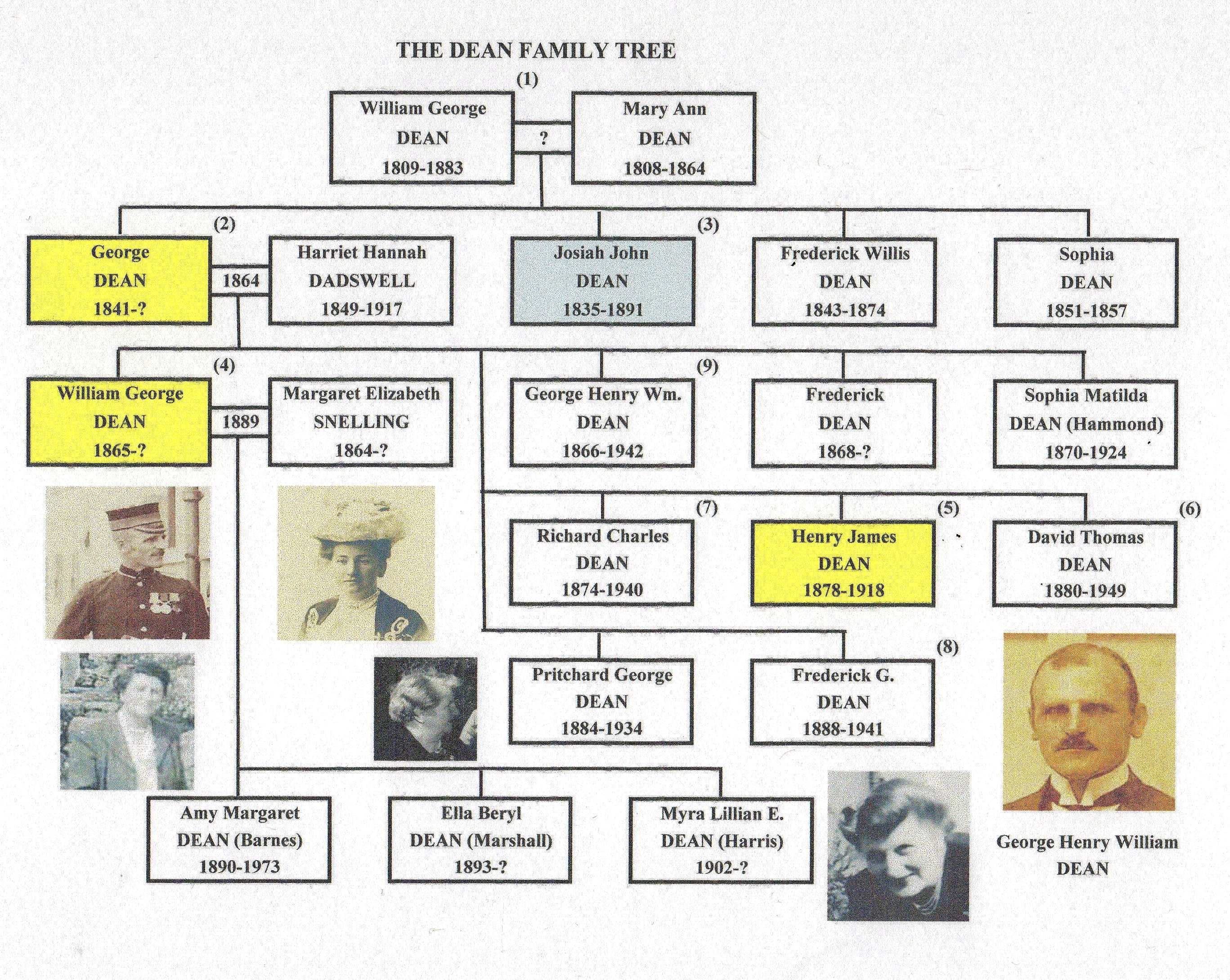
APPENDIX B. RECRUITMENT OF BOY SOLDIERS
The following information is quoted from Skelley (1977):*
“Boy enlistment was a traditional method of augmenting recruitment. Regiments consisting entirely of boys had been formed at an earlier date, but the last had disappeared in 1802. Between 1859 and 1899 regulations specified that the number was not to exceed 2 per cent of the establishment. Boys were taken on from the age of fifteen and served an apprenticeship until they reached the normal age of enlistment. During this time they were taught one of two or three trades. Nearly three-quarters of the boys recruited underwent training as musicians (i.e. drummers and buglers), the remainder as tailors and shoemakers. On reaching the minimum age for enlistment, boys formally joined the regiment to which they were attached. What was new was the suggestion inspired by the practices of the Royal Navy, of a comprehensive training scheme. Borrowing directly from the navy’s experience, many advocated that special training schools be set up, and that the establishment of boys at the Royal Military Asylum and the Royal Hibernian Military School be substantially increased.”
APPENDIX C. ENGINEER RECRUIT
TRAINING
The following is quoted from Grierson (1899):*
“With
the exception of drivers, every recruit enlisted for the “Royal Engineers”
must know some trade. The drivers
are trained at the depot of the field-engineers at Aldershot, the sappers at the
Chatham depot, where the latter are trained for a year in infantry drill and
pioneer duties. During the summer
every depot company in turn goes into a tent-camp at Wouldham near Chatham,
where the recruits are taught camp duties, pontooning &c.
The men, that are enlisted as telegraphists, photographers, printers,
lithographers, or chartographers, have to go through an abbreviated course of
pioneering; those selected for companies of submarine mining are transferred to
the mining school after having passed through their courses of infantry drill.
The engineer recruits, are allowed 100 rounds of ammunition each for
their course of target practice and fire practices 1, 2, 3, 7, 8, 10, 12, 14,
17, 19, 21, 23, and 26 of the infantry recruits’ course,+
the remainder of the ammunition being disposed of as may be found best by the
instructor.
When
the course at the depot is finished, the sappers must pass an examination, and
are then transferred to the different engineer formations, where they receive
higher pay, and may earn extra allowances by working at their special
trades."
FIRING
PRACTICE FOR ENGINEER RECRUITS
|
Number
of Practice |
Mode
of Firing |
Target |
Distance
in Yards |
Number
of Rounds |
Position
of Firing |
|
1 |
Individual
Firing |
No.
2 |
200 |
7 |
Lying |
|
2 |
“ |
“ |
“ |
“ |
Kneeling |
|
|
“ |
“ |
“ |
“ |
Standing |
|
7 |
“ |
“ |
300 |
“ |
Lying |
|
8 |
“ |
“ |
“ |
“ |
Kneeling |
|
10 |
“ |
“ |
400 |
“ |
Lying |
|
12 |
“ |
1 |
500 |
“ |
Lying |
|
14 |
“ |
1 |
600 |
“ |
Lying |
|
17 |
Rapid
Individual |
2 |
200 |
“ |
Kneeling |
|
19 |
“ |
1 |
500 |
“ |
Lying |
|
21 |
Deliberate
Volleys |
Sectional |
300 |
“ |
Front
RankKneeling |
|
23 |
Rapid |
“ |
300 |
“ |
Single
RankKneeling |
|
26 |
Rapid
Volleys |
“ |
300 |
“ |
Front
RankKneeling |
|
Target
No. |
Target
Height |
Target
Width |
Bull’s
Eye |
Circle |
|
1 |
6
ft. |
8
ft. |
3
ft. |
5
ft. |
|
2 |
6
ft. |
6
ft. |
2
ft. |
4
ft. |
APPENDIX D.
CERTIFICATES OF EDUCATION
The
following information is quoted from Skelley (1977):*
“In 1861 a new inducement towards learning was the army certificate of
education. On the recommendation of
the Council of Military Education three levels or standards were set out and
were linked with promotion in the ranks. The
third-class certificate specified the standard for promotion to the rank of
corporal: the candidate was to read aloud and to write from dictation passages
from an easy narrative, and to work examples in the four compound rules of
arithmetic and the reduction of money. A
second-class certificate, necessary for promotion to sergeant, entailed writing
and dictation from a more difficult work, familiarity with all forms of
regimental accounting, and facility with proportions and interest, fractions and
averages. First-class certificates
were a great deal more difficult and were required for commissions from the
ranks. Successful candidates had to
read and take dictation from any standard author; make a fair copy of a
manuscript; demonstrate their familiarity with more complicated mathematics,
except cube and square root and stocks and discount; and as well prepare for
examination in at least one of a number of additional subjects.
After 1887 candidates were examined in British history and geography in
place of a special subject. First-class
certificates were awarded on the results of periodic examinations held by the
Council (later Director-General) of Military Education.
Second and third-class certificates were presented on the recommendations
of the Army schoolmaster.”
“The third-class certificate of education was considered to be too high given the level of literacy of many army recruits, and the Commission+ urged the introduction of a fourth (minimum) standard.”**
APPENDIX E.
GOOD CONDUCT PAY
The following
information is quoted from Grierson (1899): *
“For good conduct, which means, that the soldier has never been punished, he receives further extra pay (Good Conduct Pay). The daily rate amounts to 1d. The recipient wears a badge in the shape of a ^, pointing upwards, on the lower sleeve of the left arm. The first of these badges is awarded after 2, the second after 6, and the third up to the sixth respectively after 12, 18, 23, and 28 years of service. Every badge brings an extra penny a day. In case of punishment the soldier forfeits this extra pay or a part of it, but can recover it by good conduct. These extra payments and badges are only awarded to men from the corporal downward.”
Over
the years during the Victorian period there were several sets of rules governing
the award of Good Conduct badges as shown below:+
·
The 1836 and 1854 rules awarded badges at 5, 10, 15, 20
and 25 years of service.
·
The 1860 rules awarded badges at 3, 8, 13, 18, 23, 28,
33, and 38 years of service.
·
The 1870 rules awarded badges at 2, 6, 12, 18, 23, and
28 years of service.
·
The 1876 rules awarded badges at 2, 5, 12, 16, 18, 21,
and 26 years of service.
·
The 1885 rules awarded badges at 2, 6, 12, 18, 23, and
28 years of service.
APPENDIX F. RE-ENGAGEMENT IN THE REGULAR ARMY
The
following information is quoted from Grierson (1899):*
“To strengthen the cadres still more and to make provision for such men as desire to earn their living in the army, certain classes of soldiers are allowed to engage for 21 years, and by this means earn a pension. The terms are as follows:-
a. Warrant Officers, Staff Sergeants, and Sergeants of the corps of Army Schoolmasters have the right after 11 years’ service, and those of other arms after 9 years’ service to engage for 21 years.
b. Corporals, bombardiers, second corporals, bandsmen, pipers and artificers may be allowed with the consent of the commander of the battalions, &c., to engage for 21 years after 9 years’ service; trumpeters, drummers, and buglers after 11 years’ service.
c. Other soldiers may have leave given them by the commander of the battalion, &c., to engage for 21 years, if they have earned two “good conduct” badges. (But as a rule this leave is granted only to men in special posts such as officers’ servants, mess waiters, &c.).
APPENDIX G. Long Service and Good
Conduct Medal
The original award of this medal in 1830 was for soldiers of “exemplary
conduct” for 21 years in the infantry and corps and 24 years in the cavalry.
In 1870 this period was reduced to 18 years for all soldiers. This was done
partially so that the medal could be worn by a soldier before his discharge to
show off his example of ‘exemplary’ service to the other men of his unit and
the army.
APPENDIX
H. CONTINUANCE WITH THE REGULAR ARMY AFTER 21 YEARS’ SERVICE
The following is quoted from
Grierson (1888):*
“In many cases Warrant Officers and Non-commissioned Officers, and in rare cases even Privates, are allowed to continue in the service after 21 years, and thus earn a higher pension. Leave for such a continuance of service must be obtained from higher authorities, without which nobody has a right to it. The only exceptions are those cases, where non-commissioned officers and men on duty at the depots or in the cadres of the militia, yeomanry, or volunteers are authorized by the commanders of their regimental district. Men on such prolonged service may claim their discharge at any time upon three months’ notice.”
APPENDIX I. 7589570 Warrant
Officer Class 1
PERCIVAL FREDERICK CHARLES DEAN
Royal Electrical and Mechanical Engineers
(formerly Royal Army Ordnance Corps)
NOTE: The information in this Appendix was provided by Michael Dean, the grandson of Percival Frederick Charles Dean and by his granddaughter Laura Green (née Dean).
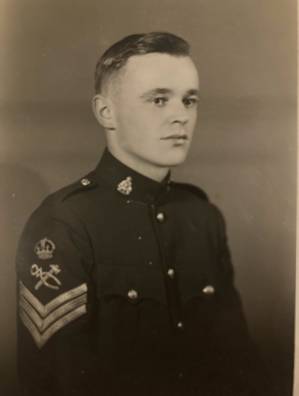
Figure 22. Staff Sergeant
Percival Frederick Charles Dean,
Royal Army Ordnance Corps
Percival Frederick Charles Dean (1913-2013) was the son of Frederick George Dean and Daisy Dean (née Fulcher) (1890-1917). He was born in Strood, Kent on 23 January 1913.
His mother Daisy died of tuberculosis in 1917 and Frederick was left to bring up his son with the help of Daisy’s family who were publicans. A pub was not deemed suitable to bring up child so Percival’s aunt, Grace Lilian Fulcher, raised him with some support from an inheritance left by Henry James Dean.
Percival followed in his family’s footsteps and joined the Army in 1937, serving first in the Royal Army Ordnance Corps and then transferring to the Royal Electrical and Mechanical Engineers. He served until 1959 and saw active service at Dunkirk and Normandy, and following World War 2 he also served in the Korea War. For his service he was awarded the following medals (from left to right in Figure 23 below):
1939-45
Star
France and German Star
Defence Medal
War Medal
Queen Elizabeth II Coronation Medal
British Korea Service Medal
United Nations Korea Service Medal
Long Service and Good Conduct Medal with bar [REGULAR ARMY]

Figure 23. The Medals of Warrant Officer Class 1 Percival Frederick
Charles Dean,
Royal Electrical and Mechanical Engineers
Percival Frederick Charles Dean lived a long life and died peacefully in Yorkshire after his 100th birthday in 2013.
REFERENCES
The Monthly Army List, April 1907, p. 807.
The Monthly Army List, January 1908, Part 2, p. 2410.
3.
Hart’s Army List, July 1911, p.
287.
4.
The Monthly Army List, December
1912, p. 806.
5.
The Monthly Army List, April 1914,
p. 807.
Hart’s
Annual Army List, 1915, Volume II, p. 943.
The
Monthly Army List, June 1917, p. 1542.
The Monthly Army List, October 1919, Part 2, p. 1704.
Census
1861 Census of England and Wales (RG9/480).
1871 Census of England and Wales (RG10/819).
1891 Census of England and Wales.
1911 Census of England and Wales.
Family Trees
Barnes Family Tree
Dean Family Tree WA
Watkins48A
Internet Web Sites
Captain Ernest Nicholas Davey, R.A. http://www.reubique.com/1851559.htm
Early Colonial Style Travel. http://earlycolonial.co.za/the-castle-of-good-hope/
Band Staff Register. http://www.bandcstaffregister.com/page154.html
Medal Rolls
Egypt 1882 Medal Roll, 8th Railway Company, Royal Engineers, WO100/64.
Royal Engineers Long Service and Good Conduct Medal Roll, WO102/7.
Royal Engineers British War Medal and Victory Medal Roll.
Great War Medal Index Card.
Official Documents
Certified
Copy of an Entry of Birth for William George Dean.
General Register Office, BXBY 565911, dated 18 October 1999.
London Gazette
The London Gazette, 2 June 1908, p. 4069.
Supplement to the London Gazette, 1 December 1917, p. 12639.
Passenger Lists
Periodicals
The
Sapper, Oct 1960, p.99.
Registers
3.
London,
England, Church of England Marriages and Banns, 1754-1932 for Margaret Elizabeth
Snelling, Greenwich, St. John the Evangelist, Blackheath, 1868-1922.
5.
England
& Wales, Civil Registration Death Index, 1916-2007
6. Death, Burial, Cemetery & Obituaries for Sophia
Matilda Hammond, June 1924.
7. Death, Burial, Cemetery & Obituaries for Frederick G. Dean, June 1941.
Royal
Engineers List
The
Royal Engineers List, August 1908.
The
Royal Engineers List, January 1912.
The
Royal Engineers List, April 1930.
The
Royal Engineers List, July 1930.
The
Royal Engineers List, April 1931.
The
Royal Engineers List, October 1932.
The
Royal Engineers List, April 1934.
The Royal Engineers List, 1943.
* SKELLEY, A.R. The Victorian Army at Home: The Recruitment and Terms and Conditions of the British Regular, 1859-1899. Mc Gill-Queen’s University Press, Montreal, 1977, p. 262.
* GRIERSON, J.M. Scarlet Into Khaki: The British Army on the Eve of the Boer War. Greenhill Books, London, 1988, p. 185.
+ See tables on the following page.
* SKELLEY, A.R. The Victorian Army At Home: The Recruitment and Terms and Conditions of the British Regular, 1859-1899. Mc Gill-Queen’s University Press, Montreal, 1977, p. 94, 95, and 311.
+ A Royal Commission was appointed in 1868 to enquire into the provisions for educating officers and officer candidates, with jurisdiction extended to cover the provisions for instructing the rank and file.
** The fourth-class certificate of education was abolished in 1888.
* GRIERSON, J.M. Scarlet Into Khaki: The British Army on the Eve of the Boer War. Greenhill Books, London, 1988, p. 227.
+ LARIMORE, F., 2003.
* GRIERSON, J.M. Scarlet Into Khaki: The British Army on the Eve of the Boer War. Greenhill Books, London, 1988, p. 24.
* GRIERSON, J.M. Scarlet Into Khaki: The British Army on the Eve of the Boer War. Greenhill Books, London, 1988, p. 24.
ENDNOTES
[i] In 1999 a search was made for his records at the Public Records Office (PRO) in London. An entry was found for his officer’s file in the appropriate index (WO338/6) but the actual file apparently never reached the PRO. About 40 percent of these files are missing for various reasons. As there is a file or has been a file, it is unlikely that the service record for his earlier time in the ranks would be available as it would have been transferred to his officer’s record file. A search was made of the WO97 series for his enlisted record with negative results.
[ii] The original designation of the Corps of Royal Engineers in which Other Ranks served before the Corps was amalgamated with the officers of the Corps of Royal Engineers.
[iii] Corporal was the highest rank that George Dean ever attained. Due to many disciplinary problems he ended his militar career as a Sapper.
[iv] Certified Copy of an Entry of Birth, General Register Office, BXBY 565911, dated 18 October 1999.
[v] See RECRUITMENT OF BOY SOLDIERS in Appendix B.
[vi] See ENGINEER RECRUIT TRAINING in Appendix C.
[vii] Monthly Army List, January 1909, Part 2, p. 2410.
[viii] Royal Engineers Egypt Medal Roll.
[ix] Later Colonel, C.B., D.S.O.
[x] Later Colonel.
[xi]
Later Lieutenant Colonel.
His service sword is in the author’s collection.
Lieutenant-Colonel Pelham
George von Donop (28 April 1851 – 7 November 1921) was a British
Army officer in the Royal Engineers and later Chief Inspecting Officer of
Railways. He represented the Royal Engineers at association football,
appearing in two FA Cup Finals, and also made two appearances for the
England national football team. He
was the godfather of the writer Sir P. G. Wodehouse, who was named Pelham in
his honour.
[xii] Later Lieutenant Colonel, D.S.O.
[xiii] Later Major General, C.B.E.
[xiv] GIBBINS, D.
[xv] Ibid.
[xvi] His exact period of service at Chatham is not known as his service records could not be located.
[xvii] London Gazette, 2 June 1908, p. 4069.
[xviii] Royal Engineers List, August 1908.
[xix] The building shown probably is not the building in which the Deans lived back in 1911 as it looks too modern for that time.
[xx] Royal Engineers List, January 1912.
[xxi] Ibid.
[xxii] Royal Engineers List, 1943.
[xxiii] This address is shown on the reverse side of his Medal Index Card when he applied for his British War Medal.
[xxiv] All these medals are in the author’s collection.
[xxv] The exact dates of some of his promotions are not known due to the non-availability of his service papers.
[xxvi] Serving in this rank on this date. Actual date of promotion is not known.
[xxvii] Wedding certificate.
[xxviii] R.E. List, April 1930.
[xxix] R.E. List, Jul 1930.
[xxx] R.E. List, Apr 1931.
[xxxi] R.E. List, Oct 1932.
[xxxii] R.E. List, Apr 1934.